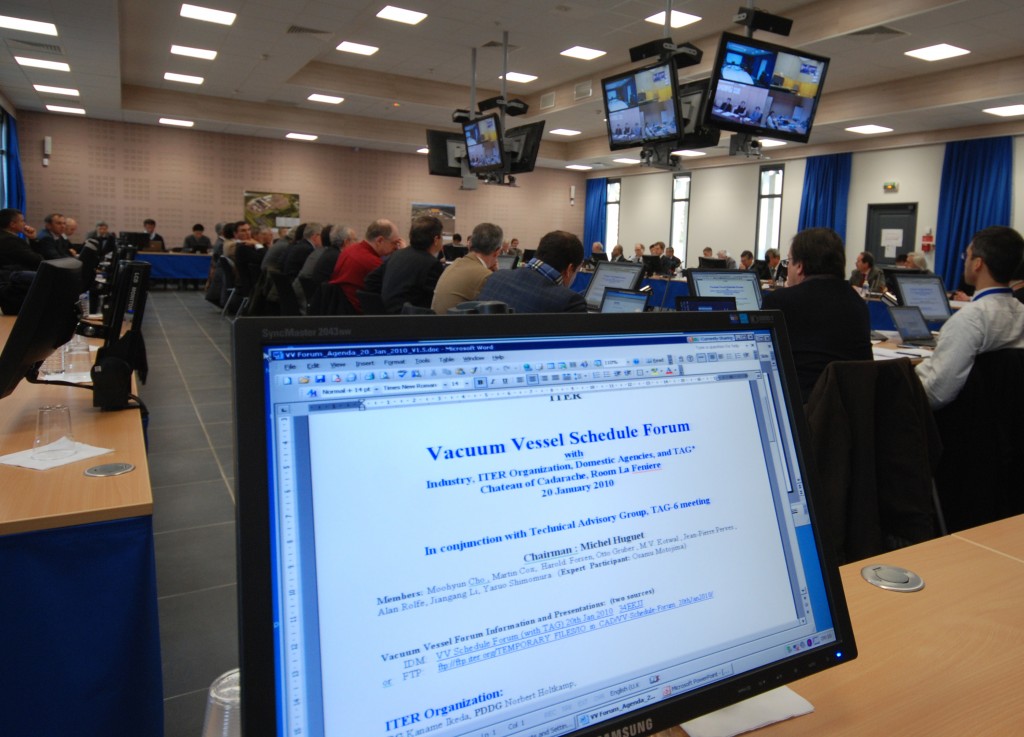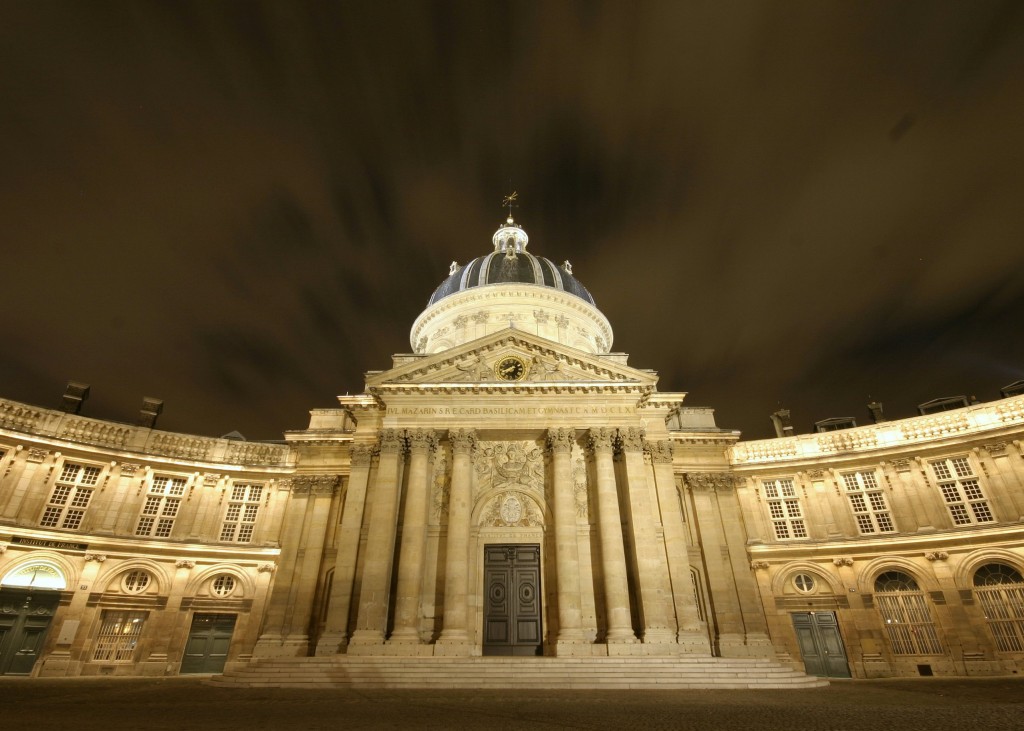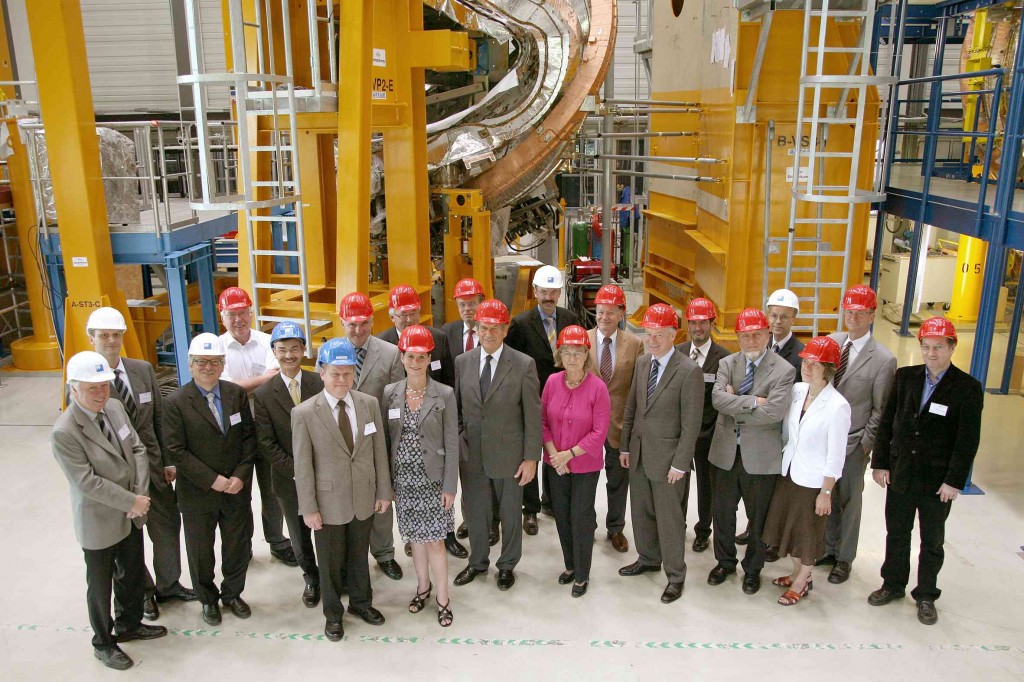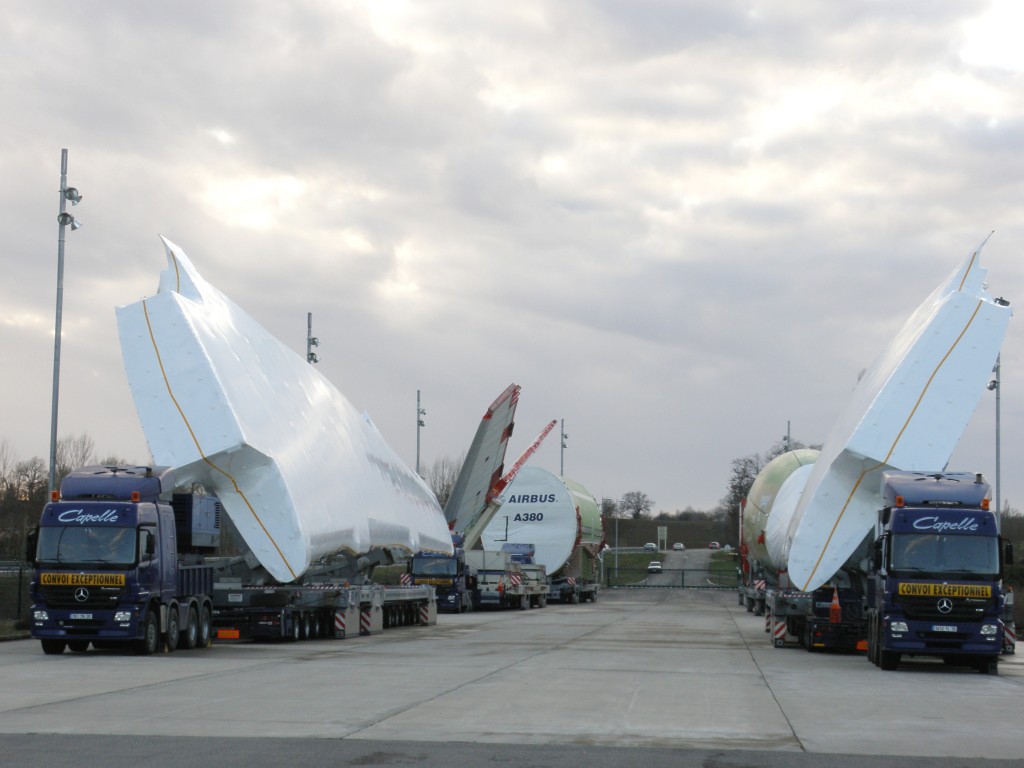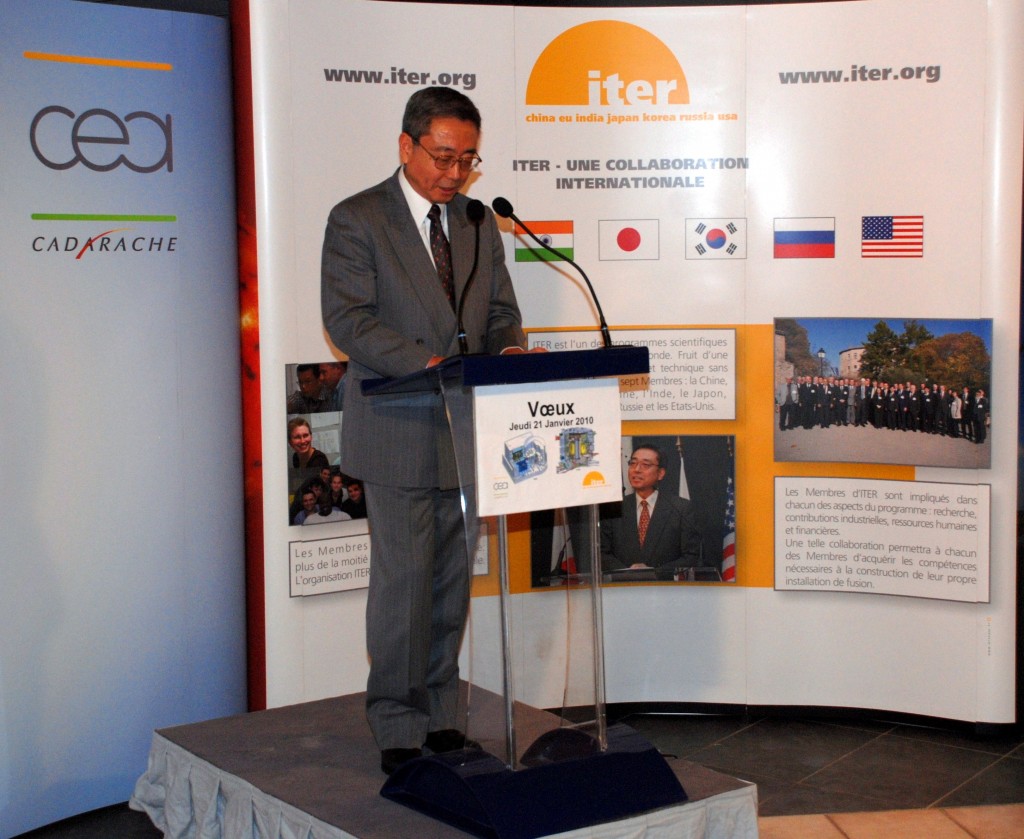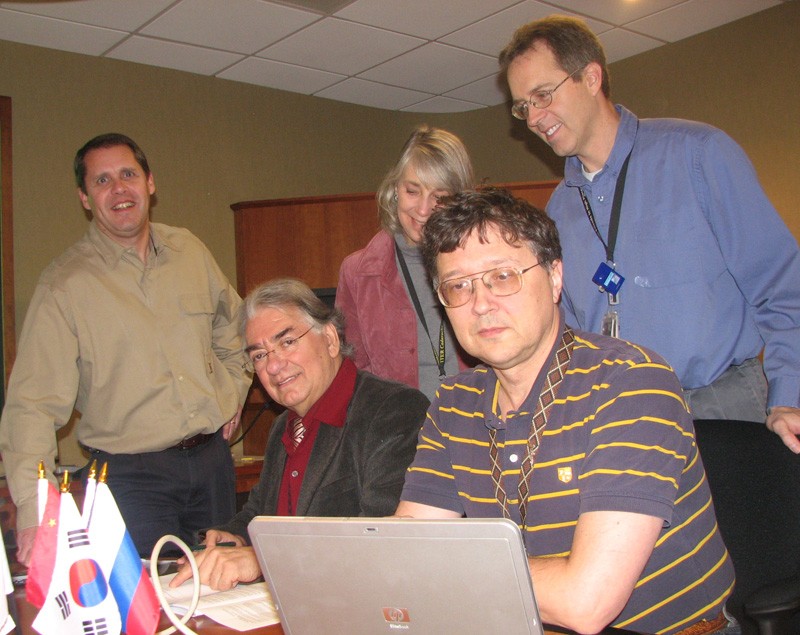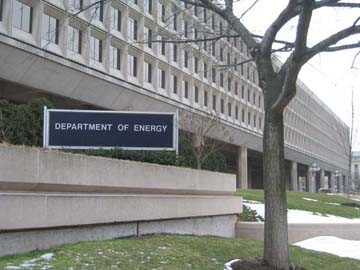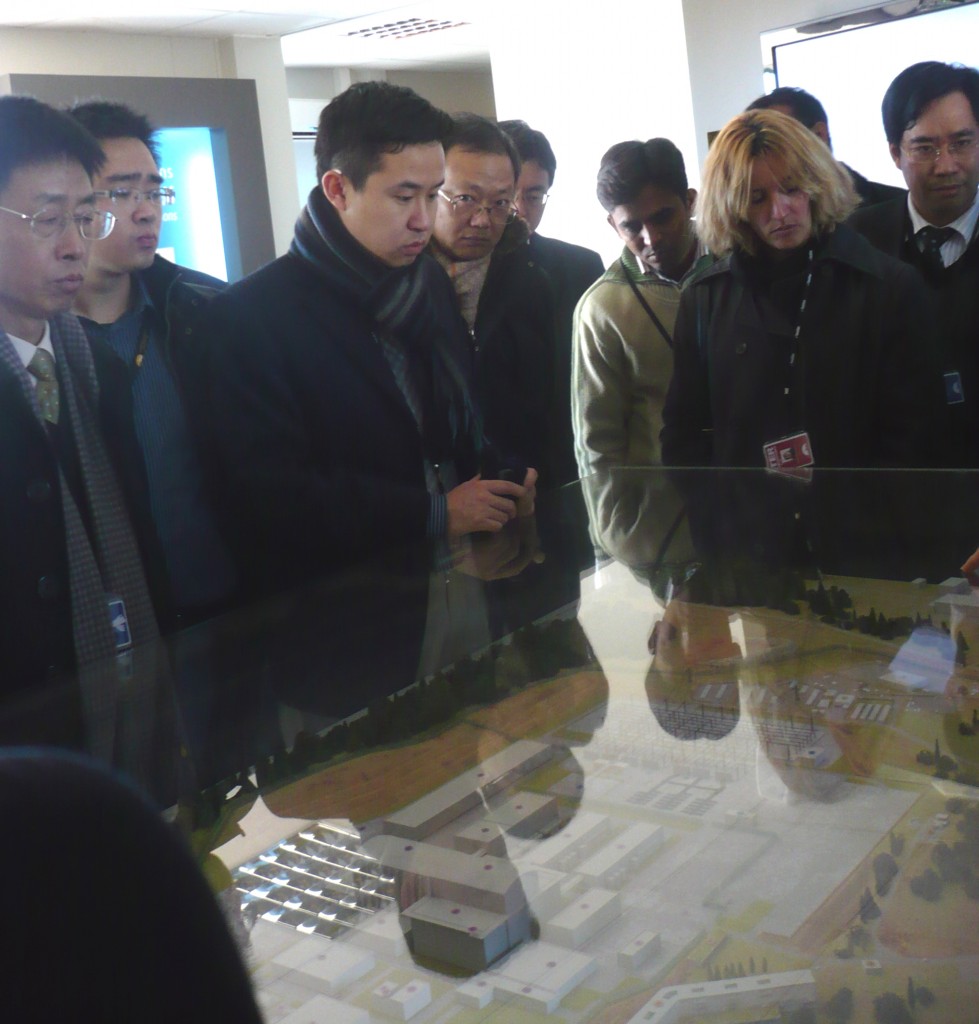Languages are like living things. They evolve, adapt, and constantly create new words or expressions to describe new realities. In France, this natural process is closely monitored by a 375-year-old institution: the "Académie Française."
One of the tasks entrusted to the Academy is to define and validate the words that emerge from the world of research and technology. The "Immortals," as French Academicians are called, also have to make sure that whenever a foreign (most frequently English) expression is adopted, a French equivalent can be coined.
This mission is what brought Academician Marc Fumarolli, along with members of the French Commission of Terminology, to Cadarache and the ITER site last Wednesday. As President of the Commission, Academician Fumarolli wished to get acquainted with a nuclear research facility ... an environment that is among the largest producers of neologisms.
CEA-Cadarache Head of Public Affairs and Communications Guy Brunel, also a member of the sub-commission on Nuclear Engineering Terminology, seized the opportunity to organize a public conference and a round table on specialized communication. On this occasion, Academician Fumarolli stressed the importance of "being precise while remaining understandable by all" and urged scientists and engineers to create new words from their own language rather than adopt English terminology.
After lunch at the Château, the visitors were greeted on the ITER site, where Thierry Brosseron of Agence Iter France gave an overview of the construction process. ITER Head of Communication Neil Calder then presented the scope and overall challenges of the project, emphasising the importance of terminology in the world of fusion science where exotic concepts and phenomena need to be named in order to be explored.
On 17 July 2009, a group called "Friends of Fusion" (Freundeskreis der Fusion) was founded in Greifswald, Germany with the aim of convincing the German government to invest more money into fusion research, and of making fusion known to the wider public. ITER Newsline talked to Günther Hasinger, Director of the Max-Planck Institute for Plasma Research (IPP) in Garching and organizer of the group, to learn more.
Newsline: So far, your group has met twice. Who are the Friends of Fusion and what is the group's purpose?
Hasinger: The idea behind this initiative is to invite a high-level group of industry representatives and academics at least once per year to interesting events and to give them privileged information about the status of fusion research. The members of the "Friends of Fusion" can then act as ambassadors in the social and political environment. The Chairman of the Friends is Hans-Dieter Harig, former CEO of the energy group e.on. Other members are Hermann Requardt, Board member of Siemens, and Ekkehard Schulz, Chairman of ThyssenKrupp. Besides e.on, all the major German energy suppliers are represented: RWE, EnBW, EWE and Vattenfall.
Prior to the foundation of the "Friends of Fusion" last summer, the three German EURATOM associations—IPP and the research facilities in Karlsruhe and Jülich—developed a plan on how to increase support for fusion research in Germany. In their paper, they called for an "Apollo Program" for energy research—i.e., the duplication of the current budget (including fusion research). Our priority would be the accelerated development of a prototype commercial fusion reactor DEMO and the IFMIF materials research facility. In our inaugural meeting, the Friends of Fusion decided to adopt this strategy and to fully support it.
Newsline: Seven months have passed since the inauguration. What has happened since?
Hasinger: The members of the club have successfully carried out their roles as ambassadors. Also, federal elections in Germany resulted in a government coalition that fully supports the development of new technologies. In fact, in the coalition agreement, fusion is mentioned as being one of the key technologies of the future. Already, things are going in the right direction—soon the long-time "cap" that was placed on funding for fusion is to be abolished. Also, the German Chancellor Angela Merkel will visit Greifswald on 1 February. Unfortunately, the rising costs of ITER hang above us like the sword of Damocles, so that there is the danger that these gains be offset by cuts in European funding again.
In our last meeting in November, we also discussed a study commissioned by RWE, e.on and Siemens and performed by McKinsey with the participation of the IPP. For this study, McKinsey interviewed a number of experts, visited several fusion labs and conducted modelling. Their study concludes that we have solutions for all the technical challenges of fusion, meaning that no technical show stopper could be identified. However the study does say that the economic aspects of fusion energy still need evaluation. The Friends have therefore committed themselves to do some homework on more detailed system studies and to come up with a clearer picture of the possible energy mix for the second half of this century. Formulating an answer to this question will be the focus of our next meeting.
Newsline: Which will happen when?
Hasinger: The next meeting is scheduled for summer 2010. I am optimistic that we will achieve our long-term goals.
On 13 and 14 January, a delegation of the ITER Transport Itinerary Coordination Group (ITICG) paid a visit to the Airbus factories in Toulouse and, later that night, witnessed the delivery of two airplane wings, a tail wing and three parts of the A380 fuselage along the convoy's last 35 kilometres from the "day" parking site at l'Isle-Jourdain to the assembly site in Toulouse.
The procedure for the assembly and delivery of the superjet's main components very much resembles that of ITER, where the big components will arrive from overseas at Berre l'Etang near Marseille and then travel along a special itinerary to Cadarache. At Airbus, major structural sections of the A380 are built in France, Germany, Spain, and the United Kingdom. Due to their size, they are delivered to the assembly hall in Toulouse, France by surface transportation.
Similar to the ITER Itinerary, roads and canals had to be widened and replaced for Airbus "convois exceptionnels," bridges were reinforced or newly built, and new barges were developed to deliver the A380 parts. It takes Airbus convoys three nights to travel the 240 kilometres between Bordeaux and Toulouse. Many spectators flank the road to see the show every time the convoys roll by; in the small village of Lévignac, convoys have to pass within centimetres of the village's homes and shops.
"The Airbus experience has already proven very useful in the preparation of the itinerary for the transport of ITER components," says Akko Maas, chair of the Coordination Group and spectator that night. "In the past we learned how to convince French administration what needs to be done; this time we learned a lot about how things are done in practice during the transport, and what they have learned from five years experience. We were very impressed by the efficiency of the operation."
After four hours, the convoy finally reached the Airbus site—allowing both drivers and spectators to return home to rest. "It was a tiring and unusual mission," Akko sums up, "but one that has greatly helped our understanding of the practical aspects of the transport of large components."
Thanks to Akko Maas for his contribution to this article.
|
"Last year I started my address by thanking you, this year I conclude my speech by thanking you!" said ITER Director-General Kaname Ikeda at the 2010 Joint CEA Cadarache/ITER Cérémonie des Voeux held on Thursday evening. He spoke in the Salle Fenière—packed with representatives from the local community. Serge Durand, Director of CEA Cadarache, stressed the links between the two organizations: "There are and I believe there will always be passages that link the CEA and ITER."
"Les Voeux" is a tradition in France that allows mayors and company heads to outline to their neighbours and colleagues the achievements of the past year and the goals for the coming year. The speeches are followed by a convivial drink.
Many thanks to the Communications team of CEA Cadarache for the organization of the event.
The US ITER Project Office has awarded a basic ordering agreement for design and fabrication of the Tokamak cooling water system (TCWS)—a major US contribution to the project—to AREVA Federal Services LLC of Charlotte, North Carolina.
The TCWS is a complex network that is subdivided into four primary heat transfer systems, chemical and volume control systems, draining and refilling systems, and a drying system. Pumps, filters, pressure vessels, heat exchangers, valves, tubing, piping, and fittings are key components. The TCWS also includes other structures and components such as supports, instrumentation and control devices, electric motors, heaters, power controllers, and associated wiring.
Specific work tasks for the basic ordering agreement will be authorized by individual task orders, which are expected to number approximately 30. Most of the TCWS subsystems are planned for delivery within the five-year duration of the agreement, although there is an option to extend if additional time is required.
"We were looking for one company that wouldn't itself do all the work, but would oversee and integrate industry activities related to the TCWS," explained US ITER Project Director Ned Sauthoff. "This provides an umbrella agreement that will allow us to send these tasks to AREVA."
"We're excited because we are actually setting up strong industrial participation. We should be able to get some of the longer-lead activities under way," he added.
The US ITER Project Office is hosted by Oak Ridge National Laboratory and supported by the US Department of Energy Office of Science.
Several research projects in fusion were among the 69 projects selected on 14 January by the US Department of Energy for the first round of its Early Career Research Program. This five-year funding initiative seeks to support exceptional young researchers in innovative, clean-energy areas.
Candidates were untenured professors working in US academic institutions or researchers at DOE national laboratories who had received a PhD within the last ten years. Some 1,750 proposals were considered for the program—projects in fusion, but also energy sciences, scientific computing, environment, high energy physics, and nuclear physics were among the winners.
Awardees will share a total of $85 million in grants to cover salary, laboratory equipment, research support staff and travel for a period of five years. The program will be renewed annually (see DOE Early Career Research Program website).
In the press release, Steven Chu, US Secretary of Energy, stated: "This investment reflects the Administration's strong commitment to creating jobs and new industries through scientific innovation."
This week, two technical meetings were held at ITER. At the Test Blanket Module port management meeting, participants from China, India and the ITER Organization discussed the activities to be performed over the next few months. The second meeting was organized between the CODAC, Heating & Diagnostics Department at ITER and the Indian Domestic Agency to discuss the design of the power supply for the diagnostic neutral beam.
On Thursday, 23 meeting participants followed the invitation to have a tour around the construction site. In front of the platform, the participants were able to look forward to the concrete realization of all of their hard work as ITER moves toward construction.
|


